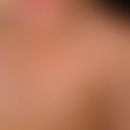Synonym(s)
HistoryThis section has been translated automatically.
Du Toit, 1993
DefinitionThis section has been translated automatically.
Rare variant of pityriasis alba, which is mainly observed in dark-skinned, mostly atopic patients.
You might also be interested in
ManifestationThis section has been translated automatically.
3-10 years, rarely adults, dark skinned individuals. No gender preference.
LocalizationThis section has been translated automatically.
Mostly occurring on the cheeks, zygomatic region, temples and forehead, but also over a large area, e.g. on the sides of the upper arms.
ClinicThis section has been translated automatically.
5-10 or more, usually lasting several months, sometimes more than 1 year, sharply defined, large, hyperpigmented, scaly patches or slightly consistency increased, little or no itching, hardly elevated plaques surrounded by a hypopigmented halo. The lesions may occur individually, but may also confluent due to appositional growth, resulting in irregularly configured garland-like areas.
HistologyThis section has been translated automatically.
Mostly discrete superficial, interstitial, lymphocytic dermatitis with low epidermotropy and spongiosis Parakeratosis is usually absent. Focal pigment incontinence.
Differential diagnosisThis section has been translated automatically.
Tinea faciei: More pronounced itching, faster progression, more pronounced inflammatory lesions, more prominent edges, fungal evidence.
Eczema atopic: The pityriasis alba (faciei) can be interpreted as a minimal form of atopic eczema. The frequent association with other atopic stigmata speaks for this. However, it can also occur without an atopic relationship, as an independent clinical picture. A "classical" possibly also monotopic facial atopic eczema shows clearly stronger signs of inflammation.
External therapyThis section has been translated automatically.
Short-term (several weeks), daily mild corticoid externa. Trials with 0,1% Tacrolimus ointment were promising.
Progression/forecastThis section has been translated automatically.
Permanent, chronic course over months, often more than 1 year. The foci heal completely without residual changes.
Note(s)This section has been translated automatically.
The anti-inflammatory therapy approaches lead to a complete repigmentation of the affected areas after a longer period of time.
LiteratureThis section has been translated automatically.
- Blessmann Weber M (2002) Pityriasis alba: a study of pathogenic factors. J Eur Acad Dermatol Venereol 16: 463-468
- Dhar S (1995) Pigmenting pityriasis alba. Pediatric Dermatol 12: 197-198
- Du Toit MJ et al (1993) Pigmenting pityriasis alba. Pediatric Dermatol 10: 1-5
- Galan EB (1998) Pityriasis alba. Cutis 61: 11-13
In SI et al (2009) Clinical and histopathological characteristics of pityriasis alba. Clin Exp Dermatol 34:591-597
Wolf R et al (1985) Extensive pityriasis alba and atopic dermatitis. Br J Dermatol 112: 247
Incoming links (1)
Pityriasis alba;Disclaimer
Please ask your physician for a reliable diagnosis. This website is only meant as a reference.




